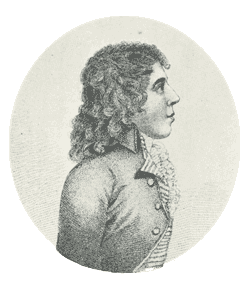William Nelson Gardiner, Engraver
(b. 1766, d. 1814)
Engraver
From A Dictionary of Irish Artists 1913

William Nelson Gardiner. Engraving.
Was born in Dublin on 11th June, 1766, the son of John Gardiner, "crier and factotum" to William Scott, Justice of the King's Bench, and his wife Margaret Nelson, a pastry cook in Henry Street. He received a good education at Sisson Darling's Academy in Mabbot Street, and showing a talent for drawing was placed in the Dublin Society's School in 1781. He studied there for three years, obtaining a silver medal, and then went to London to try his fortune. For a time he endeavoured to support himself by painting portraits and assisting a Mr. Jones in making profile shade likenesses. He then tried the stage, joining a company of players as scene-painter and actor. This did not last long, and he again found employment in doing profile shades for Mrs. Beetham of 27 Fleet Street. Becoming acquainted with Francis Grose, the antiquary, he was placed by him with R. Godfrey, the engraver of "The Antiquarian Repertory." He became a skilful engraver and was employed with Bartolozzi and others, by Sylvester and Edward Harding in engraving plates for their publications, the "Biographical Mirror," "Shakespeare Illustrated," "The Economy of Human Life," "Memoirs of Count de Gramont," etc.
He subsequently worked for Bartolozzi, whose style he imitated, and he claimed some of the plates bearing Bartolozzi's name, particularly those in Lady Diana Beauclerk's "Dryden's Fables." He was attaining some position for himself as an engraver and might have gained fame and independence, but, as he says of himself, he was "gay, volatile and lively as a lark"; he disliked his sedentary occupation, and throwing up his profession he went to Dublin where he spent all his money. He then returned to England, and resolving to take orders, he entered Emmanuel, and afterwards Corpus Christi College, Cambridge. He took his degree in 1797 as 5th Senior Optime, and remained at Cambridge some time in hopes of obtaining a Fellowship; but failing in his attempts he abandoned the idea of taking orders and quitted the University.
For a time he worked for his former patron, E. Harding, in copying oil pictures in water-colour: "the best artists in England," he says in his biography, "are my witnesses that I beat hollow every one else." He does not appear to have returned to engraving. He exhibited at the Royal Academy subject pictures or drawings in 1787, 1788, 1792 and 1793. About 1801, his eyes having begun to fail, he was compelled to relinquish drawing, and having a good knowledge of books set up as a bookseller in Pall Mall. His varied knowledge and his brilliant though eccentric conversation attracted people to his shop, though he never scrupled to deliver his opinions on public men in the freest terms, regardless of consequences, in their presence.
The Rev. T. F. Dibdin introduced him into his "Bibliomania" under the character of Mustapha, and his portrait in that character was engraved. Gardiner retaliated with stinging sarcasm in his published catalogues. He did not prosper in his new profession; after the death of his wife and child, his eccentricities became more marked, he was regardless of all the forms of social life and grew more slovenly and dirty in his dress and habits. He suffered from ill-health, and on the 8th May, 1814, he put an end to his own life in his house in Pall Mall . He left a letter to a friend which showed that his act was deliberate: "Sir, I cannot descend to the grave without expressing a due sense of the marked kindness with which you have favoured me for some years. My sun is set for ever; a nearly total decline of business, the failure of my catalogue, a body covered with disease though unfortunately of such a nature as to make life uncomfortable without the consoling prospect of its termination, has determined me to seek that asylum 'where the weary are at rest.' My life has been a continual struggle, not indeed against adversity, but against something more galling, and poverty having now added herself to the list, has made life a burden. Adieu, Sir, and believe me your sincere and respectful humble servant, William Gardiner." A biographical memoir, written by himself, will be found in the "Gentleman's Magazine," Vol. LXXXIV, p. 622.
In the National Portrait Gallery, London, is a small water-colour portrait by him of Philip, first Earl of Hardwicke. Among his engraved works, besides his plates in Harding's publications already mentioned, are:
Dr. Thomas Arne. Etching, after J. Nixon.
George, Prince of Wales. Engraved by N. Young in "Sentimental and Masonic Magazine," 1792, after a painting by Gardiner.
Daniel Mendoza, pugilist. Etching after Robineau, 1789.
Thomas Ryder, in the character of Sir John Restless in "All in the Wrong." Stipple after Harding, 1787. A scarce print.
Duchess of Rutland; after R. Stanier.
Henry Stebbing, D.D.; after N. Dance. Frontispiece to "Verses to his Memory," 1791.
Tom Thumb of Bristol, aged 135; after T. Barker, 1795.
Mary Lady Walpole.
Sir Charles Hanbury Williams.
Mrs. Wilson, actress; after J. D. Harding, 1787.
The Kentish Girl; after Harding.
The Staffordshire Girl; after Harding.
The Buckinghamshire Girl; after Harding.
Girl of Co. Wicklow; after J. Nixon.
Evening; after J. Harding.
The Scholar; after Harding and Evans.
The Dunce; after Harding and Evans.
The Relentless Father; after F. Wheatley.
The Tender Father; after F. Wheatley.
Illustrations to "Castle of Otranto"; after J. Harding.
"January" and "February"; two of the plates in the series of "The Months," after W. Hamilton, the rest being engraved by Bartollozzi, 1788.
Seven prints, after J. F. Rigand in "Life of Mary Stuart."
In the Nottingham Museum are three small drawings in Indian ink, illustrations to Blair's "Grave"; and one for the frontispiece to Gay's "Fables."
